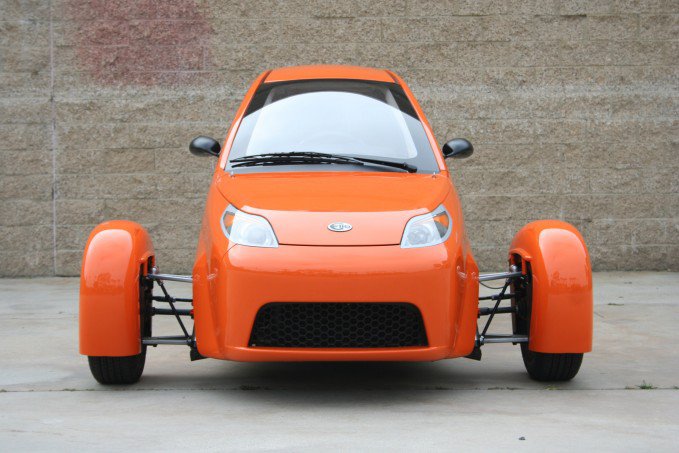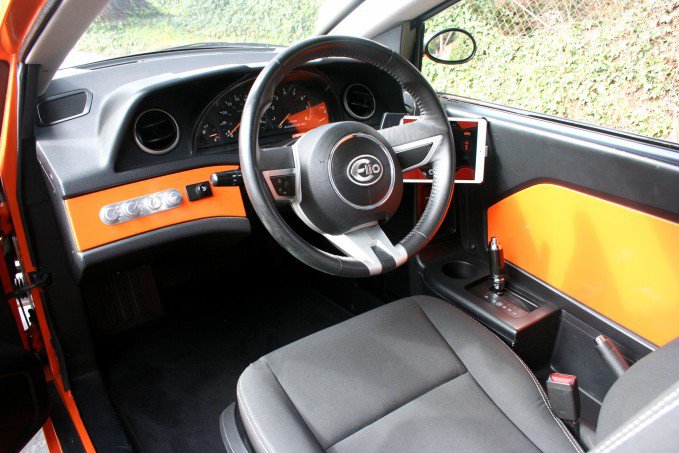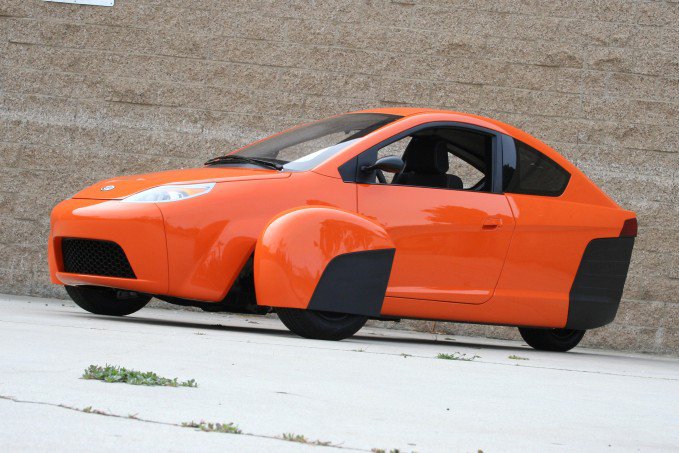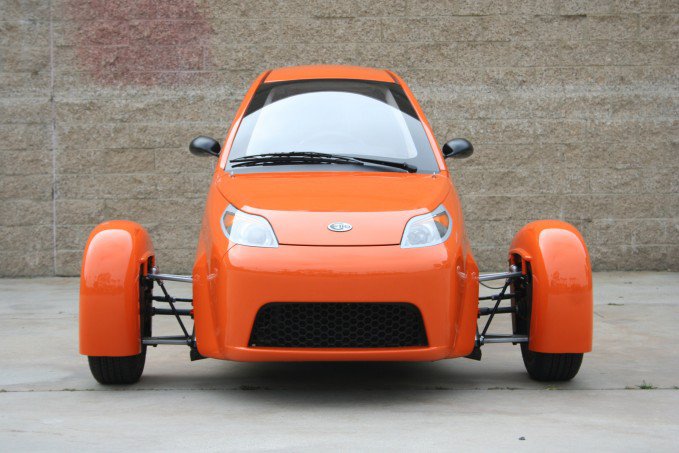Automakers don’t often let journalists like us drive their prototype cars, and if they do, it’s usually under closely controlled circumstances. So we knew the folks at Elio were either very confident or very foolish when they sat us down in their three-wheel P4 prototype, pointed us out into Los Angeles’ afternoon traffic, and told us to have at it.
“Just keep in mind that this is a prototype and won’t go much faster than 30,” we were told. (Shhh—we got it up to 40.) “Oh, and the seat belt doesn’t work.” Now there’s an incentive to drive carefully.
And Now For Something Completely Different
As we weaved our way through the traffic, we tried to remember that the Elio is not supposed to be a plaything like the Polaris Slingshot or the Morgan 3-Wheeler. This is a people’s car: Small, efficient and affordable, a viable new-car option for the 95 million or so hundred-thousand-mile plus “clunkers” on American roads, most of which average 17 MPG or less. The Elio is a volks wagen—a people’s car for post-recession America.
Still, it’s hard to not to grin when you’re driving something as unusual as the Elio. The driver sits directly in the center of the car, with the passenger seat directly behind. Access is through a single door on the left side.
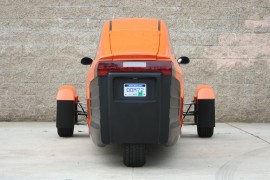
The car we drove is the P4 prototype, one generation away from the production-ready P5, which Elio hopes to start building at an ex-GM plant in Shreveport, Louisiana in 2016. Among the production elements missing from the P4 is the powertrain: The P5 is to be powered by a bespoke 0.9-liter three-cylinder engine supplied by German engineering firm IAV.
The P4 we drove is powered by the 1.0-liter Suzuki engine from a Geo Metro. Don’t laugh: Its physical size makes it a good stand-in for the IAV engine, and its output is not far off from the production model’s estimated 55-60 horsepower and 55 lb-ft of torque.
The prototype’s acceleration was hampered by a three-speed automatic transmission; the P5 will get two more ratios courtesy of either a five-speed manual or a clutchless sequential automatic transmission (the latter similar in operation to the transmission in the Smart ForTwo, though Elio says theirs will shift more smoothly).
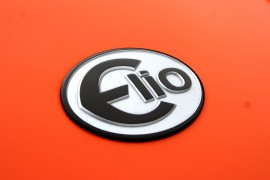
Responsive chassis, heavy steering
Our test drive did give us a good feel for the front-wheel-drive Elio’s chassis setup. The suspension consists of A-arms up front and a motorcycle-style single-sided swing-arm out back, all held up by a coil-over-shock spring setup. The P4’s ride is firm and busy, but the suspension does an admirable job of taking the edge off the bumps; certainly the adjustable shocks (which will be optional on the production car) deserve some credit here.
Handling is good fun: Despite its rather skinny tires, the P4 develops impressive grip, and our tester was grinning like an idiot after flinging it through a few corners.
The non-assisted steering is heavy—yeah, we know, non-assisted steering is supposed to be heavy, but not this heavy—and feels less precise on-center than we would have liked. (Elio says the prototype is about 200 lbs heavier than the production car, which could affect steering effort.) Oh, and while we’re complaining, visibility to the rear is lousy: The lid for the Elio’s vestigial trunk is where a rear window ought to be, and the prototype’s tiny side mirrors don’t provide much useful information.
Is it safe?
One advantage of the in-line seating is that the Elio provides plenty of shoulder room, along with adequate leg- and head-room. And having some lateral distance from other cars on the road is nice; it staves off that feeling of vulnerability one has when one is towered over by Honda Fits and Chevrolet Sonics.
We were encouraged by the Elio’s crash-test simulations, which show that the P5 should achieve five stars in the government’s front, side and rear impact crash tests—if they can get NHTSA to crash one, that is. Technically, the Elio is an autocycle, not a car, which means it does not require crash testing. Elio says NHTSA wants to crash test a P5, but can’t quite figure out how to do the paperwork.
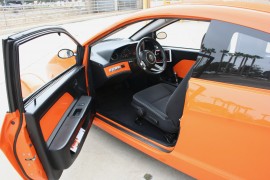
Frankly, the biggest problem we encountered was when we (reluctantly) turned the P4 into the parking lot. The driver’s shoulders sit about two feet inboard of the front wheels, and when the parking-ticket machine spit out our ticket, we couldn’t reach it. Unless they have gorilla arms, Elio drivers are going to have a hell of a time at toll booths, drive-up ATMs and drive-through fast food joints.
As you like it
Nearly as intriguing as the car itself is the way Elio plans to sell it. The P5 will be sold at company-owned retail outlets and affordability is key: Elio is planning on a base price of $6,800 plus an as-yet-to-be-determined destination fee. All P5s will have air conditioning as standard, and the sole factory option will be an automatic transmission, most likely priced around $800.
Elio plans to offer a unique financing scheme, which will essentially be a credit card secured by the car itself. For every dollar you buy in gas, Elio will add a $2 car payment—so if you spend $20 to fill your Elio, $40 will come due against the car. This means you’ll be financing your gas at credit-card rates, but having the card backed by the car should keep interest rates low while helping buyers who have had a rough go during the recession to rebuild their credit history. (Buyers can also finance the old-fashioned way by arranging a third-party motorcycle loan.)
If you have more to spend on your Elio, you’ll be pleased to know that the sky is the limit on options. Like most cars, the P5’s parts and subassemblies are built by third-party suppliers; unlike most other automakers, Elio isn’t shy about this fact, and pretty much anything offered by those suppliers can be had as an option on the car.
Navigation, leather seats, a sunroof—if a supplier makes it, Elio will fit it to the car. And if a supplier doesn’t make it, Elio will support third-party companies in creating new accessories—providing they will sell them through Elio retailers with a 20% cut for Elio.
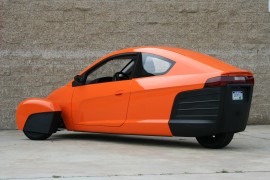
Oddly enough, servicing will not be handled by factory retailers; instead, Elio is planning to partner with Pep Boys, a nationwide auto parts and service chain. The plan is to have at lest one ASE-certified and Elio-trained mechanic at each location. For
areas not served by Pep Boys, Elio is exploring the option of contracting with local independent mechanics.
Parts availability should not be a major concern, as the P5 uses off-the-shelf parts engineered for other vehicles. Even though you can’t buy a P5 yet, Elio claims that nearly 80% of its parts can be purchased today at your local auto parts store.
THE VERDICT: Elio P4 Review
We’re intrigued by the prospect of the P5—but is Elio being too optimistic? In order to be financially viable, the company needs to sell well over 100,000 P5s per year—in fact, they’re counting on sales of 150,000 to 250,000 units. That means they’d have to out-sell well-established brands like Mazda, BMW, Mitsubishi, Volvo, Audi, Porsche, and Jaguar Land Rover.
Elio is an unknown company, and they’re selling a very unusual car to a very conservative public. It’s an uphill battle, to say the least—but we do admire Elio’s pluckiness.







